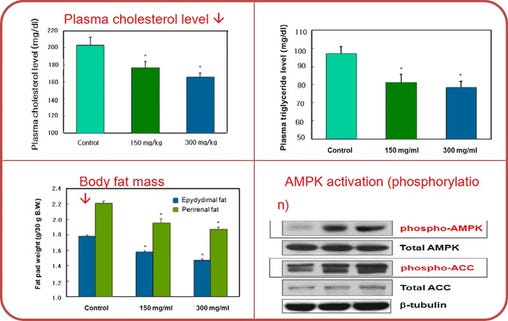Finding a New Way to Turn on the Master Metabolic Switch (Part 2 of 2)
Gencor’s chief scientific advisor, Dr. Paul Clayton breaks down the testing behind its new weight management product, ActivAMP.
To read part 1, click here.
New Ways to Activate AMPK
Recent research by NASA and others showed the existence of a second pathway that achieved AMPK activation -- namely resistance exercise. Work by the Lee Laboratories at the University of Michigan and other groups has demonstrated that this involves the up-regulation of genes which code for a family of at least three stress-inducible proteins called sestrins (9, 10). The sestrins are classified as “alarmins,” a growing family of stress-inducible (i.e., hormetic /protective) proteins that include the HSPs (heat shock proteins) and AMPs (anti-microbial proteins).
The HSPs are preferentially induced by thermal, osmotic and oxidative stresses, and the AMPs are preferentially induced by the presence of potential pathogens. However, the sestrins appear to be preferentially induced by physical stresses as detected by transponder systems in skeletal muscle and bone.
The xeno-hormetics, formerly categorized as adaptogens, are known to act inter alia by inducing stress proteins such as the HSPs. Recently, a number of traditional xeno-hormetic herbs have been screened for sestrin/AMPK activity. During ethno-botanical screening in South Korea, experts identified the herb Gymnestemma pentaphyllum as a candidate for research. Traditionally made into a tonic for the frail and elderly, its documented benefits reproduce the expected effects of exercise or AMPK activation. The fact that its traditional name Jiaogulan translates as “little herb of immortality” further sparked the researchers’ interest. They soon established that extracts of this herb did indeed activate AMPK, presumably via sestrin up-regulation. As a result of this pioneering work, an extract of Gymnestemma pentaphyllum standardized to its actives, saponins known as damulins (12), is now available as ActivAMP.
Proof of Concept: Pre-clinical
Pre-clinical work established that ActivAMP exerted the same effects in ob/ob mice as the herb did in humans, and also promoted weight management (13). The two saponins, Damulin A and B, were potent AMPK activators, considerably more so than AICAR, a molecule that also activates AMPK and is thought to have won several Tours de France before it was banned in 2011(14, 15). (See Figure 1.)
Proof of Concept: Clinical
A program of clinical work was subsequently initiated and the first of these, a study of the effects of ActivAMP, has been published in the prestigious journal Obesity (8).
In this double-blind trial, 80 subjects with a BMI between 25-30 were randomized to active or placebo groups and treated for 12 weeks. The active group received capsules containing 450 mg ActivAMP per day. No recommendations were made regarding dietary or exercise. At trial end, total abdominal fat area, body weight, body fat mass, percent body fat, and BMI were significantly decreased (p=0.044, p<0.05, p<0.0001, p< 0.0001, and p< 0.05, respectively) in the active group compared to the placebo group. Interestingly, the reductions in visceral adiposity were particularly marked, as they are following exercise. No clinically significant changes in any safety parameter were observed.
Summary
ActivAMP is a tool to help activate the profound energy-switching enzyme AMPK, and replicate the metabolic and health benefits of exercise. It also clearly has a role in sports and athletics, where its ability to improve muscle fitness is creating interest in professional circles.

REFERENCES
Chau JY, Grunseit AC, Chey T, Stamatakis E et al (2013). Daily sitting time and all-cause mortality: a meta-analysis. PLoS One. 8(11):e80000.
Egan B, Zierath JR (2013). Exercise metabolism and the molecular regulation of skeletal muscle adaptation. Cell Metab. 17(2):162–184.
Menendez JA, Joven J, Aragonès G et al (2013). Xenohormetic and anti-aging activity of secoiridoid polyphenols present in extra virgin olive oil: a new family of gerosuppressant agents. Cell Cycle 12(4):555-78.
Baar K (2006). Training for endurance and strength: lessons from cell signalling. Med Sci Sports Exerc. 38(11):1939–1944
Burcelin R, Crivelli V, Perrin C et al (2003) GLUT4, AMP kinase, but not the insulin receptor,are required for hepatoportal glucose sensor-stimulated muscle glucose utilization. J Clin Invest 111:1555–1562
Davies SP, Carling D, Munday MR, Hardie DG (1992) Diurnal rhythm of phosphorylation of rat liver acetyl-CoA carboxylase by the AMP-activated protein kinase, demonstrated using freeze-clamping. Effects of high fat diets. Eur J Biochem 203:615–623
Calabrese V, Cornelius C, Cuzzocrea S et al (2011.) Hormesis, cellular stress response and vitagenes as critical determinants in aging and longevity. Mol Aspects Med. 32:279–304.
Park SH, Huh TL, Kim SY, Oh MR et al (2014). Antiobesity effect of Gynostemma pentaphyllum extract (actiponin): A randomized, double-blind, placebo-controlled trial. Obesity (Silver Spring). (1):63-71
Lee JH, Budanov AV, Karin M (2013). Sestrins orchestrate cellular metabolism to attenuate aging. Cell Metab. 18(6):792-801.
Lee JH, Budanov AV, Talukdar S et al. Maintenance of metabolic homeostasis by Sestrin2 and Sestrin3. Cell Metab. 2012 Sep 5;16(3):311-21.
Nguyen PH, Gauhar R, Hwang SL et al (2011) New dammarane-type glucosides as potential activators of AMP-activated protein kinase (AMPK) from Gynostemma pentaphyllum. Bioorg Med Chem 19:6254-6260.
Razmovski-Naumovski V, Huang TH, Tran VH, Li GQ et al (2005) Chemistry and pharmacology of Gynostemma pentaphyllum. Phytochem Rev 4:197-219.
Gauhar R, Hwang SL, Jeong SS et al (2012). Heat-processed Gynostemma pentaphyllum extract improves obesity in ob/ob mice by activating AMP-activated protein kinase. Biotechnol Lett. 34(9):1607-16.
Benkimoun P (2009). Police find range of drugs after trawling bins used by Tour de France cyclists. BMJ. 339:b4201.
Private communications
About the Author
You May Also Like